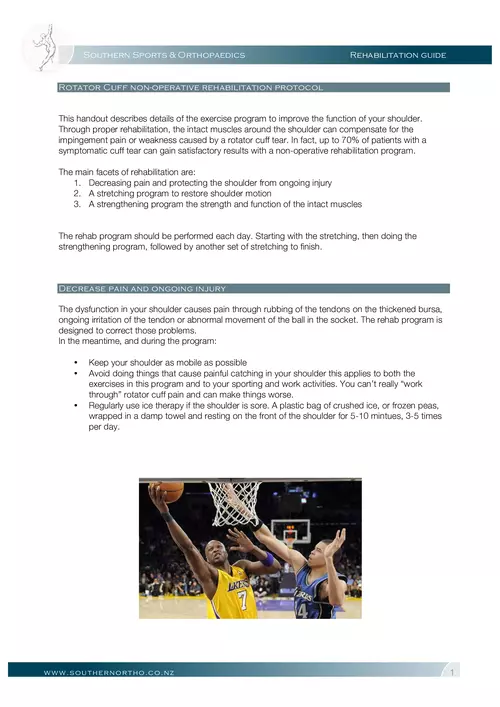
1 Southern Sports & Orthopaedics Rehabilitation guide Rotator Cuff
With the arm straight bring the hand to your side. To make the exercise harder you can step away so the band is tight then recommence your exercises. You can
adsPart of the document
1
Southern Sports & Orthopaedics Rehabilitation guide
www.southernortho.co.nz Rotator Cuff non-operative rehabilitation protocol
This handout describes details of the exercise program to improve the function of your shoulder.
Through proper rehabilitation, the intact muscles around the shoulder can compensate for the
impingement pain or weakness caused by a rotator cuff tear. In fact, up to 70% of patients with a
symptomatic cuff tear can gain satisfactory results with a non-operative rehabilitation program.
The main facets of rehabilitation are:
1.Decreasing pain and protecting the shoulder from ongoing injury
2.A stretching program to restore shoulder motion
3.A strengthening program the strength and function of the intact muscles
The rehab program should be
performed each day. Starting with the stretching, then doing the
strengthening program, followed by another set of stretching to finish.
Decrease pain and ongoing injury
The dysfunction in your shoulder causes pain through rubbing of the tendons on the thickened bursa,
ongoing irritation of the tendon or abnormal movement of the ball in the socket. The rehab program is
designed to correct those problems.
In the meantime, and during the program:
•Keep your shoulder as mobile as possible
•Avoid doing things that cause painful catching in your shoulder this applies to both the
exercises in this program and to your sporting and work activities. You can't really "work
through" rotator cuff pain and can make things worse.
•Regularly use ice therapy if the shoulder is sore. A plastic bag of crushed ice, or frozen peas,
wrapped in a damp towel and resting on the front of the shoulder for 5-10 mintues, 3-5 times
per day.
2
Southern Sports & Orthopaedics Rehabilitation guide
www.southernortho.co.nz
Stretching program
This program is made up of a series of stretches; each designed to improve the flexibility of a specific
region of the shoulder capsule and shoulder girdle. Proper performance of the stretching program
should ensure balanced shoulder flexibility.
Frequency
Each stretch should be performed 3-5 times during a session of exercises. Stretching sessions should
be performed 3 times per day to prevent scar tissue from reforming between sessions.
If too much time is allowed between sessions, the shoulder will tighten back up, resulting in little
progress.
Duration
When the limit of a stretch is reached, it should be held for a minimum of 30 seconds. Remember to
relax and breathe as the stretch is held. Do not bounce at the end range, rather apply persistent gentle
pressure during the count. Repeat each stretch 3-5 times and try to push a little farther with each
repetition.
Exertion
At the beginning of a stretching program, the shoulder may initially ache more as a result of the
exercises. This should not cause concern and you should continue to work through the discomfort,
which should subside with continued efforts. If stretching results in moderate to severe pain that lasts
for greater than 15 minutes following the program, you should back off on the exertion.
The directions of stretch
you need to concentrate on are:
1.Pendulums ܆
2.External rotation ܆
3.Forward flexion (reaching up overhead) ܆
4.Cross body reaching ܆
5.Internal rotation (reaching up behind the back) ܆
6.Abduction (reaching out to the side) ܆
7."Sleeper " stretch ܆
1. Pendulums
Stand next to a table or support and lean forward.
Gently let the involved arm hang down freely and relaxed.
Swing your arm forwards, backwards, sideways and in circles,
using gravity to help you. Initially perform this exercise for 1
minute, 3-4 times (rest between sets).


